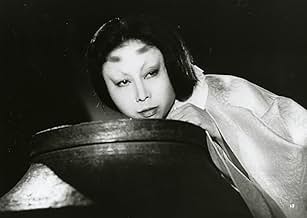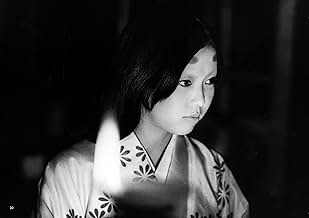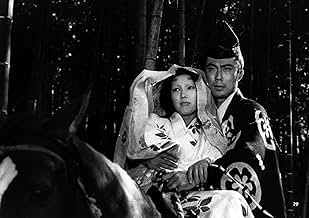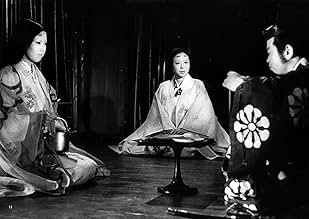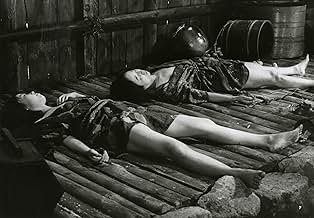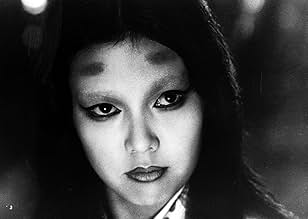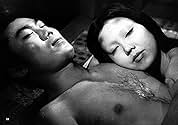IMDb रेटिंग
7.7/10
9.4 हज़ार
आपकी रेटिंग
अपनी भाषा में प्लॉट जोड़ेंTwo women are raped and killed by samurai soldiers. Soon they reappear as vengeful ghosts who seduce and brutally murder the passing samurai.Two women are raped and killed by samurai soldiers. Soon they reappear as vengeful ghosts who seduce and brutally murder the passing samurai.Two women are raped and killed by samurai soldiers. Soon they reappear as vengeful ghosts who seduce and brutally murder the passing samurai.
- पुरस्कार
- कुल 2 जीत
फ़ीचर्ड समीक्षाएं
THE SYNOPSIS In warring feudal Japan, a group of marauding Samurai seeking food exits the forest where they come across a house that should have what they require. On entering the house they find it has what they want and a lot more
.it has women too. The inhabitants an elderly woman and her daughter in law are both subjected to continuous rape as each Samurai takes their turn, the others plunder the women's food stocks.After the Samurai have satiated their appetites,they leave the women, now unconscious for dead and set fire to their home as they flee.When the fire eventually burns out all we see are the burned and battered bodies of the women and their helpless black kitten as it licks their wounds.
Rajomon Gate .a Samurai approaches on horseback and is met by a spectral vision of a woman, who tells him she is too afraid to make her journey home because she has to pass the Bamboo Grove, which is a haven for bandits and highwaymen. The Samurai agrees to accompany her to her home, where he is plied with sake. The Daughter in laws husband Hachi, we learn has been at war for three years and has still not returned The daughter in law then proceeds to seduce the Samurai, before she brutally attacks him, devouring his throat and sucking his blood ..for we learn that the two women are in fact the newly embodied spirits of the dead women murdered by the Samurai who have made a pact with the Evil Gods/Spirits, who have allowed them life, on condition that they murder all Samurai who pass their way.
Far to the East, a sole warrior named Hachi is all that remains after a massive and bloody battle.Hachi returns home to find his home burned and his family missing, he seeks employment from the Samurai leader at Rajomon Gate named Raiko, who after hearing Hachi's brave stories takes him on. Hachi's first task is to rid the area of the spectral beasts that have been claiming the lives of his warriors ..and so Hachi sets off unknowingly to kill his own family.
THE REVIEW Unquestionably a companion piece to Onibaba, a film by the same Director it was made to cash in on the success of Onibaba which had been met by a wave of good criticism in the west .and also because Shindo's other contemporary works had been less critically received mainly due to their overtly sexual content. Kiyomi Kuroda's award winning cinematography sets the tone for this film, its Chiaroscuro/Noir visuals are nothing short of breathtaking. The underlying tragic story of lost love is also dealt with brilliantly by Shindo who is on fine form again .the story is compelling except for the first twenty minutes which became a bit repetitive as Samurai after Samurai was seduced and killed by the women, but this ploy was used to bring the story forward so I wont criticize too much.All in all, a worthwhile buy if you like Onibaba or Asian Cinema,but the DVD despite the films stunning print is very bare.
Rajomon Gate .a Samurai approaches on horseback and is met by a spectral vision of a woman, who tells him she is too afraid to make her journey home because she has to pass the Bamboo Grove, which is a haven for bandits and highwaymen. The Samurai agrees to accompany her to her home, where he is plied with sake. The Daughter in laws husband Hachi, we learn has been at war for three years and has still not returned The daughter in law then proceeds to seduce the Samurai, before she brutally attacks him, devouring his throat and sucking his blood ..for we learn that the two women are in fact the newly embodied spirits of the dead women murdered by the Samurai who have made a pact with the Evil Gods/Spirits, who have allowed them life, on condition that they murder all Samurai who pass their way.
Far to the East, a sole warrior named Hachi is all that remains after a massive and bloody battle.Hachi returns home to find his home burned and his family missing, he seeks employment from the Samurai leader at Rajomon Gate named Raiko, who after hearing Hachi's brave stories takes him on. Hachi's first task is to rid the area of the spectral beasts that have been claiming the lives of his warriors ..and so Hachi sets off unknowingly to kill his own family.
THE REVIEW Unquestionably a companion piece to Onibaba, a film by the same Director it was made to cash in on the success of Onibaba which had been met by a wave of good criticism in the west .and also because Shindo's other contemporary works had been less critically received mainly due to their overtly sexual content. Kiyomi Kuroda's award winning cinematography sets the tone for this film, its Chiaroscuro/Noir visuals are nothing short of breathtaking. The underlying tragic story of lost love is also dealt with brilliantly by Shindo who is on fine form again .the story is compelling except for the first twenty minutes which became a bit repetitive as Samurai after Samurai was seduced and killed by the women, but this ploy was used to bring the story forward so I wont criticize too much.All in all, a worthwhile buy if you like Onibaba or Asian Cinema,but the DVD despite the films stunning print is very bare.
While watching 'Kuroneko,' I must admit I was a little distracted by what were, to me, anyway, stylistic issues: The beautiful black-and-white photography was so vivid and made clear so many little details, in contrast to which the story and the action was delivered in broad, stylized strokes. Something about this didn't work for me - the image, somehow, was too unforgiving on the simply conceived story...not to mention the makeup effects. When a shot of thrillingly real roaring fire at the opening is followed by a shot of the burned bodies, two actresses with, essentially, charcoal rubbed on parts of their arms and legs, and lumpy fake blood spread on their throats...well, it hurt my ability to get into the world of the movie. As did sequences of the plot where the characters' actions didn't follow normal human psychology ("But if he recognized her, wouldn't he say something?") If the image hadn't been so vivid I wouldn't have had to keep thinking of them as actors in a stilted, stylized script. But I did. So sue me. Maybe that's culture clash - maybe the dramatic stylization is direct from the Japanese tradition and would have felt natural in its own way to someone from Japan. Well. I'm not Japanese.
But the important thing here is that, while the movie's horror, while I was watching it, was negligible because of all the above...in the days following, I found myself more and more haunted by some of the truly eerie imagery and the undertones of the plot. To return home, having become a man, and find that your family has turned to demons - demons who might sometimes, partially, still be your family, but will never talk about it...there are shadows of a powerful nightmare in there.
The fight sequence in the rushes, and the slow processions through the bamboo grove, in particular, reverberate in my mind. These scenes, among others, were well supported by the excellent musical score.
I don't know what to make of the last few scenes - the movie had spent itself several times over by that point, though, and in a sense, the exact twists and turns of the plot were only of secondary importance. Watch it for its uniquely eerie atmosphere (and lovely photography), and then enjoy as it slowly settles in to your subconscious.
But the important thing here is that, while the movie's horror, while I was watching it, was negligible because of all the above...in the days following, I found myself more and more haunted by some of the truly eerie imagery and the undertones of the plot. To return home, having become a man, and find that your family has turned to demons - demons who might sometimes, partially, still be your family, but will never talk about it...there are shadows of a powerful nightmare in there.
The fight sequence in the rushes, and the slow processions through the bamboo grove, in particular, reverberate in my mind. These scenes, among others, were well supported by the excellent musical score.
I don't know what to make of the last few scenes - the movie had spent itself several times over by that point, though, and in a sense, the exact twists and turns of the plot were only of secondary importance. Watch it for its uniquely eerie atmosphere (and lovely photography), and then enjoy as it slowly settles in to your subconscious.
Although somewhat similar in both tone and presentation to director Kaneto Shindō's earlier masterpiece Onibaba (1964), Kuroneko (1968) - which translates roughly as "the black cat" - adds a more theatrical, expressionistic element to the overall design of the film, which here works towards reinforcing the more obvious spiritual/supernatural elements of the story and that unforgettable sense of nocturnal, dreamlike abstraction. As is often the case with Japanese supernatural horror stories, the plot of the film is an incredibly simple and moralistic one, dealing primarily with the notions of revenge and retribution re-cast as a pointed supernatural metaphor, with much emphasis placed on the overriding ideas of coincidence, karma and fate. In keeping with these particular ideas, Shindō creates a slow and atmospheric work that takes full advantage of the stark, unearthly ambiance suggested by the high-contrast black and white cinematography, which really helps to further underline the creation of this barren, war-torn period setting, filled with danger and despair.
Unlike Shindō's two most famous films of this period, the aforementioned Onibaba and his earlier classic The Naked Island (1960), Kuroneko sees the director moving even further away from his earlier interest in naturalistic environments - and the use of those unforgettable landscapes to underline the unspoken elements of the drama - and instead illustrates an interest in studio-based production, in a clear attempt to capture the sense of desolate, otherworldliness presented by the claustrophobic netherworld that the spirits of the film inhabit. By mixing these two styles together - cutting from a location to a studio to illustrate the characters moving between the two different worlds of the film - Shindō is able to create a further degree of heightened atmosphere, tension and theatrical abstraction that is further illustrated by the expressive use of costumes and kabuki-like make-up effects, combined with the director's continuing experiments with sound design and atonal musical composition.
The harsh tone of the film is established right from the very beginning, with the opening scene still standing as one of the most shocking and memorable of 1960's cinema, as Shindō takes us right back to the unforgettable images of Onibaba and a scene of deplorable brutality that will reverberate throughout the rest of the film. Here, we fade in on a shot of a small hut surrounded by long billowing grass and tall, leafy trees in the heart of rural Kyoto. Shindō holds the shot for an incredibly long time, establishing the incredibly slow and deliberate pace that the rest of the film will employ, before we finally see an armed warrior emerging from the bushes. His movements are slow and furtive, as he stealthily moves closer to the hut looking for food and supplies. Eventually, more soldiers appear, phantom-like from foliage and move closer towards the hut. Sleeping inside are an old woman and her daughter in law. The soldiers descend on the hut, much to the shock and surprise of the two women who try desperately to force the intruders away; however, eventually realising that the supply rations of the hut are meagre and unsatisfactory the soldiers gang-rape the two women, and burn their hut to the ground.
Here, Shindō films a violent scene that could have easily become lurid and exploitative with a pervasive sensitivity; establishing the brutality to come before cutting to an exterior shot that he once again holds for a number of minutes, creating a tragic subversion of the previously tranquil setting that opened the film. As the smoke begins to pour from the hut and the soldiers, once again, ghost-like and oppressive, filter back into the tree line we know that the film has crossed a threshold into darker territory from which it simply cannot return. With the thematic elements of this tragic, dramatic set up - combined with the period in which the film is set and the approach of the director - you can certainly see positive similarities to Ingmar Bergman's punishing rape/revenge drama The Virgin Spring (1960). However, whereas Bergman used this aspect of the plot to riff on spirituality and a suffocating, existentialist riddle; Shindō is instead more interested in mining a path of slow-building terror and blood-thirsty retribution.
To reveal any more would spoil the impact of the film and the odd, erotic atmosphere that Shindō skilfully creates through the combination of stylised photography, choreography, production design, lighting, music and editing. It is at times reminiscent of Mario Bava's excellent Gothic horror films The Mask of Satan (1960) and Kill, Baby... Kill (1966) in regards to the evocative stylisations and emphasis on mood and design; though also bringing to mind the brilliance of Masaki Kobayashi's masterpiece Kwaidan (1964), in particular the segment entitled "The Woman of the Snow". If you're already familiar with Onibaba (one of the greatest films ever made), then you'll have some idea of what to expect from the direction of Kuroneko, with the incredibly atmospheric use of black and white cinematography - making full use of that expansive, Cinemascope frame - augmented by an intelligent approach to production and location design and the slow, evocative atmosphere of nocturnal nightmare and fever dream obsession created by the story itself.
Unlike Shindō's two most famous films of this period, the aforementioned Onibaba and his earlier classic The Naked Island (1960), Kuroneko sees the director moving even further away from his earlier interest in naturalistic environments - and the use of those unforgettable landscapes to underline the unspoken elements of the drama - and instead illustrates an interest in studio-based production, in a clear attempt to capture the sense of desolate, otherworldliness presented by the claustrophobic netherworld that the spirits of the film inhabit. By mixing these two styles together - cutting from a location to a studio to illustrate the characters moving between the two different worlds of the film - Shindō is able to create a further degree of heightened atmosphere, tension and theatrical abstraction that is further illustrated by the expressive use of costumes and kabuki-like make-up effects, combined with the director's continuing experiments with sound design and atonal musical composition.
The harsh tone of the film is established right from the very beginning, with the opening scene still standing as one of the most shocking and memorable of 1960's cinema, as Shindō takes us right back to the unforgettable images of Onibaba and a scene of deplorable brutality that will reverberate throughout the rest of the film. Here, we fade in on a shot of a small hut surrounded by long billowing grass and tall, leafy trees in the heart of rural Kyoto. Shindō holds the shot for an incredibly long time, establishing the incredibly slow and deliberate pace that the rest of the film will employ, before we finally see an armed warrior emerging from the bushes. His movements are slow and furtive, as he stealthily moves closer to the hut looking for food and supplies. Eventually, more soldiers appear, phantom-like from foliage and move closer towards the hut. Sleeping inside are an old woman and her daughter in law. The soldiers descend on the hut, much to the shock and surprise of the two women who try desperately to force the intruders away; however, eventually realising that the supply rations of the hut are meagre and unsatisfactory the soldiers gang-rape the two women, and burn their hut to the ground.
Here, Shindō films a violent scene that could have easily become lurid and exploitative with a pervasive sensitivity; establishing the brutality to come before cutting to an exterior shot that he once again holds for a number of minutes, creating a tragic subversion of the previously tranquil setting that opened the film. As the smoke begins to pour from the hut and the soldiers, once again, ghost-like and oppressive, filter back into the tree line we know that the film has crossed a threshold into darker territory from which it simply cannot return. With the thematic elements of this tragic, dramatic set up - combined with the period in which the film is set and the approach of the director - you can certainly see positive similarities to Ingmar Bergman's punishing rape/revenge drama The Virgin Spring (1960). However, whereas Bergman used this aspect of the plot to riff on spirituality and a suffocating, existentialist riddle; Shindō is instead more interested in mining a path of slow-building terror and blood-thirsty retribution.
To reveal any more would spoil the impact of the film and the odd, erotic atmosphere that Shindō skilfully creates through the combination of stylised photography, choreography, production design, lighting, music and editing. It is at times reminiscent of Mario Bava's excellent Gothic horror films The Mask of Satan (1960) and Kill, Baby... Kill (1966) in regards to the evocative stylisations and emphasis on mood and design; though also bringing to mind the brilliance of Masaki Kobayashi's masterpiece Kwaidan (1964), in particular the segment entitled "The Woman of the Snow". If you're already familiar with Onibaba (one of the greatest films ever made), then you'll have some idea of what to expect from the direction of Kuroneko, with the incredibly atmospheric use of black and white cinematography - making full use of that expansive, Cinemascope frame - augmented by an intelligent approach to production and location design and the slow, evocative atmosphere of nocturnal nightmare and fever dream obsession created by the story itself.
Some obvious similarities to Shindo's earlier ONIBABA, as a woman and her mother-in-law are raped by samurai, and turn to supernatural forces to seek their revenge. Shindo uses an impressive array of tricks to maintain the unsettling, creepy atmosphere -- sparse Noh-style staging, bold chiaroscuro lighting, avant-garde soundtrack, abrupt time cuts, wire work, superimpositions and other special effects. It's a very atmospheric kaidan, almost Gothic in tone. Rape is of course a disturbingly common occurrence in Japanese cinema, but here Shindo uses it as the groundwork for a decidedly feminist agenda. The film does have a few pacing issues, particular during the erotic portions in the middle (although some of it is lovely). I thought more could have been done with this story, but the visual aspects and the mood make it memorable.
This is the best ghost movie I have ever seen, and highly unusual. It has gorgeous black and white cinematography, an exotic Japanese feudal setting, and a wide variety of visual and emotional effects. The characters move with the ritual formality that I love in certain Japanese films, and the story moves on with the ruthless intensity of a Noh drama.
The final scene is thrilling. The cinematic supernatural effects are sparingly used and startling.
The final scene is thrilling. The cinematic supernatural effects are sparingly used and startling.
क्या आपको पता है
- ट्रिवियाThe movie was placed in competition at the 1968 Cannes Film Festival, but the festival was canceled due to the civil unrest events of May 1968 in France.
- गूफ़When the cat crawls over the bodies after the fire, the mother can be seen to breathe.
- कनेक्शनFeatured in Ebert Presents: At the Movies: एपिसोड #2.15 (2011)
टॉप पसंद
रेटिंग देने के लिए साइन-इन करें और वैयक्तिकृत सुझावों के लिए वॉचलिस्ट करें
- How long is Black Cat?Alexa द्वारा संचालित
विवरण
- रिलीज़ की तारीख़
- कंट्री ऑफ़ ओरिजिन
- भाषा
- इस रूप में भी जाना जाता है
- Kuroneko, el grito del sexo
- उत्पादन कंपनी
- IMDbPro पर और कंपनी क्रेडिट देखें
- चलने की अवधि1 घंटा 39 मिनट
- रंग
- पक्ष अनुपात
- 2.35 : 1
इस पेज में योगदान दें
किसी बदलाव का सुझाव दें या अनुपलब्ध कॉन्टेंट जोड़ें

टॉप गैप
By what name was Yabu no naka no kuroneko (1968) officially released in India in English?
जवाब

